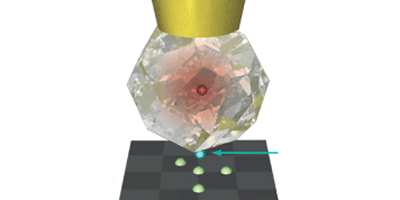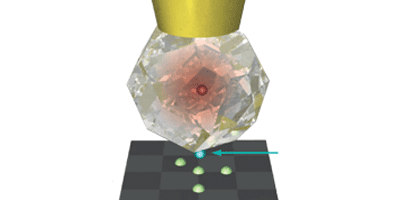Pairing up to Detect Tiny Magnetic Fields
Researchers dream of identifying individual atoms by measuring their magnetic fields. Technologies such as atomic-force microscopes (AFMs) can probe structures at the atomic scale, but aren’t sensitive to the tiny magnetic fields associated with each atom.
One proposal to get better sensitivity would exploit the so-called NV center in diamond crystals, which consists of a missing atom, or vacancy, next to a nitrogen impurity. An electron at this defect can retain its quantum coherence for up to a millisecond, which makes it easier to measure tiny shifts in its oscillation frequency caused by a magnetic field. To measure fields from a sample, a tiny diamond crystal containing an NV center could be attached to an AFM tip.
To measure the field from a nucleus, however, the detector should ideally be within a few nanometers of it, both to measure its position and because its field is much bigger nearby. Unfortunately, an NV center loses its long lifetime if it is near the diamond surface, because it is no longer surrounded by a perfect crystal. In Physical Review Letters, Marcus Schaffry of Oxford University, UK, and colleagues propose adding a second spin system, such as a molecule, on the surface of the diamond, to respond to the local field. That response in turn affects an NV center deep in the crystal, which is measured using laser and microwave pulses.
The team calculates that their measurement protocol could have a sensitivity and resolution that is significantly better than the basic NV sensor, and thus able to detect the spin of a single proton. But it won’t be easy, since controlled placement of a single “spin amplifier” complicates the already formidable challenge of arranging a diamond with a single NV center on an AFM. – Don Monroe





